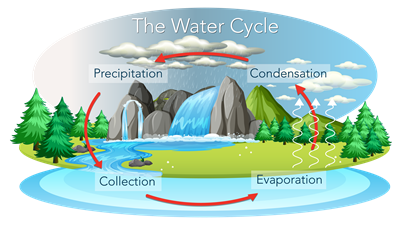PDF chapter test TRY NOW
Major elements of weather and climate
- Temperature
- Rainfall
- Pressure
- Humidity and
- Wind
Temperature
Sun's rays are the source of heat for the Earth and its atmosphere. The fall of the Sun's rays on Earth is called insolation. Temperature is one of the chief elements determining weather and climate.
The level (degree) of heat present in the air is termed as temperature, or in general, the degree of hotness or coldness of a body is called as temperature.
Temperature is subjected to vary with the level of radiation reaching the Earth surface. This again depends on the motion of the earth (rotation and revolution) and the tilt of the Earth's axis.
Through the process of evaporation, condensation and precipitation, the temperature influences the level of humidity. The Earth receives heat energy from Sun's rays through three mechanisms, radiation, conduction and convection. Terrestrial radiation heats up Earth's atmosphere more than that of insolation.

Temperature varies both horizontally and vertically. Temperature decreases with increasing altitude (height) is known as the Lapse rate, which is 6.5\ degree celsius per 1000\ meters\ in the troposphere.
Iso means "equal". Lines with prefix Iso- are lines joining the places of equal values on the map.
Based on the element of climate/weather taken into consideration, isolines are given different names as follows. And they show the distribution of various weather elements.
Based on the element of climate/weather taken into consideration, isolines are given different names as follows. And they show the distribution of various weather elements.
Isotherm: Equal temperature
Isocryme: Equal lowest mean temperature for a specified period
Isohel: Equal sunshine
Isallobar: Equal pressure tendency showing similar changes over a given time
Isobar: Equal atmospheric pressure
Isohyet: Equal amount of rainfall
Isocryme: Equal lowest mean temperature for a specified period
Isohel: Equal sunshine
Isallobar: Equal pressure tendency showing similar changes over a given time
Isobar: Equal atmospheric pressure
Isohyet: Equal amount of rainfall
Factors affecting the distribution of temperature are latitude (distance from the equator), altitude (height), nature of the land (relief), ocean currents, prevailing winds, slope, shelter and distance from the sea, natural vegetation, and soil.
